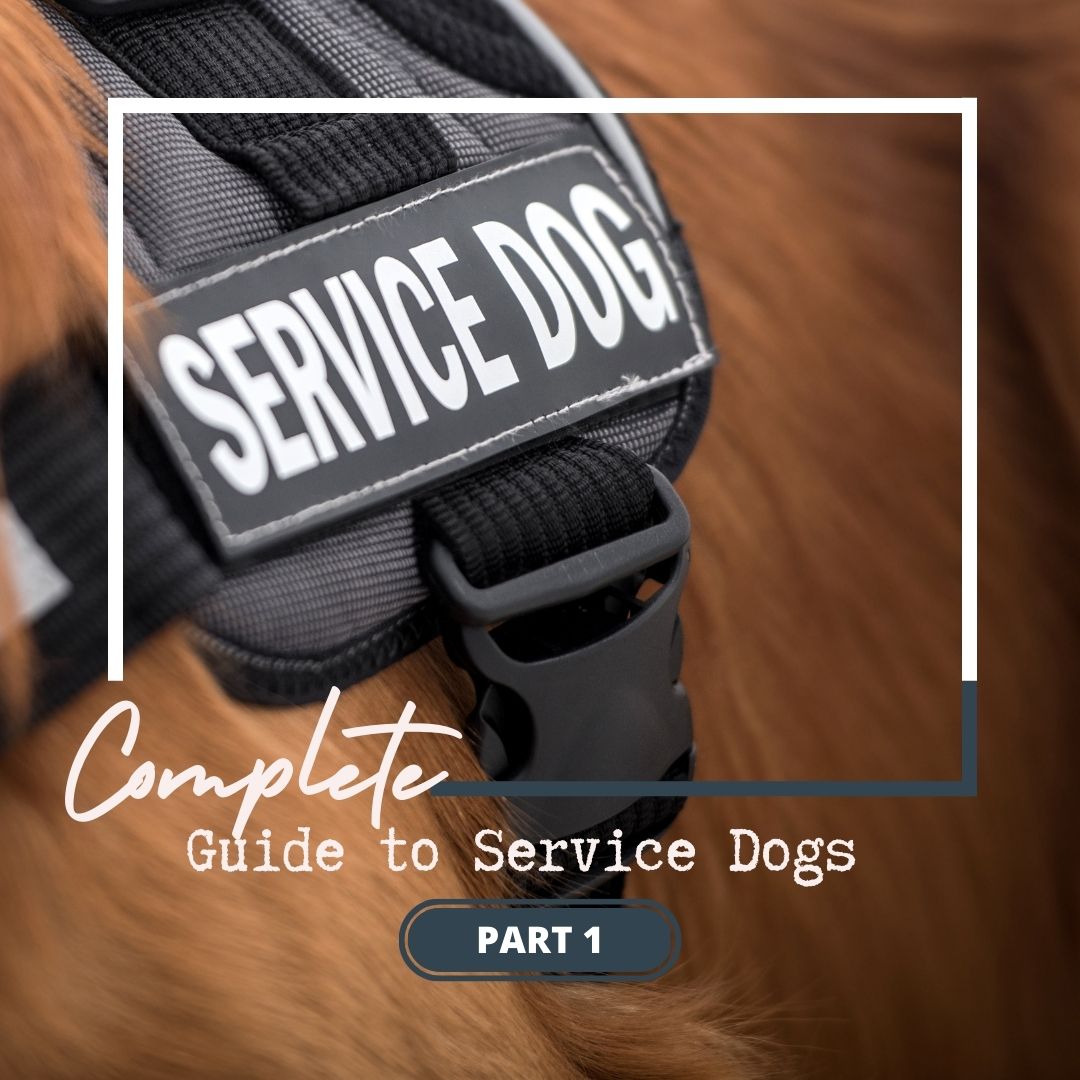Welcome to the complete beginner’s guide to service dogs.
Today, we’re going to tackle service dogs; types, breeds and characteristics of a good service dogs.
You and I know this topic can seem vast and complicated. However, I will do my best to make the complexity accessible and doable.
Service dogs perform an important role in the lives of people with disabilities, ranging from autism to physical impairments. In addition to supporting their owners with day-to-day duties, some are specifically trained for individuals with epilepsy, post-traumatic stress disorder (PTSD), or seizure disorders. In addition to the pragmatic role, they play in their partner’s lives, service dogs also are loving and cherished companions.
In the post, I will review the definition of a service dog, explore the types of breeds typically used, define the categories/types of service dogs and review the advantages of having a service dog.
If you have any questions as you’re going through it, you can reach me at yolanda@comfortingATsolutions.com and I’ll do my best to answer them.
Service Dog Overview
What is a service dog exactly?
You may be coming from my Instagram post over at @theaccessibility_NP but found yourself wanting more detailed information.
Then you’ve come to the right place because I’m about to break things down so they’re clear and understandable.
In the most basic terms, a service dog helps a person with a disability lead a more independent life. Got it so far?
Let’s kick that up a slight notch; a service dog is trained to take a specific action that helps relieve an individual’s disability.
We can take it up to an even higher level; according to the Americans with Disabilities Act (ADA) Title II (State and local government services) and Title III (public accommodations and commercial facilities), “Service animals are defined as dogs that are individually trained to do work or perform tasks for people with disabilities. Examples of such work or tasks include guiding people who are blind, alerting people who are deaf, pulling a wheelchair, alerting and protecting a person who is having a seizure, reminding a person with mental illness to take prescribed medications, calming a person with Post Traumatic Stress Disorder (PTSD) during an anxiety attack, or performing other duties. Service animals are working animals, not pets. The work or task a dog has been trained to provide must be directly related to the person’s disability.”
The ADA clearly pointed us in the right direction and defined what a service dog is now let’s dig a little deeper in that direction.
Is every dog in a vest a service dog?
An essential first step in recognizing a service dog is first understanding that NOT EVERY DOG IN A VEST IS A SERVICE DOG.
This is because even though some service dogs may wear harnesses, collars, vests or tags, the ADA does not require service dogs display identification. On the other hand, many dogs that do wear ID vests or tags specifically are not actual service dogs.
Still with me? I think it is important to note by the ADA definition of service animals “Dogs whose sole function is to provide comfort or emotional support do not qualify as service animals under the ADA.”
Check out this great infographic for a quick reference to help you remember. The differences between a service dog and an emotional support (ESA) ESA Infographic.
Service dogs have full public access rights, which means they can go places where other animals are not allowed. This includes restaurants, libraries, hospitals and public transportation.
Time to pat yourself on the back; you’re on your way to becoming a service dog superstar!
Common Service Dog Breeds
When you first think of service dogs what are the breeds that first come to your mind? I would venture to guess Golden Retrievers, German Shepherds and Labrador Retrievers would be in the top three. Even though these three are among popular choices there are many other breeds that make excellent services dogs, some of which might surprise you.
Here is a snapshot of the 10 best breeds for service dogs:
- Labrador Retriever
- Golden Retriever
- German Shepherd
- Poodle
- Boxer
- Great Dane
- Border Collie
- Pomeranian
- Bernese Mountain Dog
- American Staffordshire Terrier
The best service dogs are intelligent and have temperaments that make them simple to train. Additionally, they should have a calm, friendly and loving disposition. It is imperative that service dogs stay engaged, attentive, and alert to their owners’ needs, and unmoved by groups of persons, road traffic, noisy conditions, or other disturbances.
For more information on some of the breeds mentioned above check out this article by K9 of Mine.
Now that we have discussed the basic characteristics of a service dog. Next up you will have to identify your area of disability and service need.
That will give you a better idea of the type of service dog you will need for support.
For example:
An individual who requires a service dog primarily for mobility support would not look for a provider who trains services dogs primarily as autism support as that would be inappropriate for their requirements based on the 8 Types of service dogs.
8 Types of Service Dogs
- Mobility Assistance Dogs are trained to assist individuals who have difficulty with mobility and balance issues such as difficulty walking, paralysis, or who are prone to falling. Mobility service dogs specifically trained to brace partners with balance issues and additionally can support in everyday tasks such as opening doors, turning on lights, using automatic buttons and retrieving objects.
- Allergy Detection Dogs are used by individual with anaphylactic allergies so severe that they could enter into anaphylactic shock simply by touching trace quantities of a substance. Even though allergy detection dogs are regularly described t just as “peanut dogs,” these dogs can be utilized to detect any allergen. Whether it is peanuts, tree nuts, milk, eggs, soy, wheat or any other substance, a highly trained detection dog can examine the environment and alert to any residue that could trigger its owner to go into anaphylaxis.
- Autism Service Dogs are often matching with children and are trained to support in navigating social settings. Autism service dogs provide judgement-free love and companionship, which can help improve communication skills and with emotional support. Additionally, Autism service dogs are trained to keep children from running away and can also track them if they elope. They can also interrupt harmful self-injurious behavior or alert the parents of a child with autism to a possibly hazardous situation. If their handler is a young child and/or non-speaking, autism service dogs should carry emergency procedures and contact information.
- Diabetic Alert Dogs offer those with diabetes more independence to enhance their quality of life by alerting ahead of time that a blood sugar decrease is impending. There are distinctive odors that accompany different blood sugar levels and diabetes alert dogs are trained specifically to their partner’s scent. By having this training this allows the service dog to alert when their blood sugar level is approximately at 70, which allows them time to take the necessary precautions and medications before their levels drop further. You may be wondering how a service dog would alert in this type of situation. Well, they are able to retrieve diabetes test kits or medications, provide walking or sitting supports, carry objects, and even open cabinets, doors or drawers to name a few.
- Guide Dogs are service dogs for the visually impaired and are the most highly known type of service dogs. It’s fairly simple to place this kind of service dog because they wear a special harness that dispenses pressure in a specific way, allowing a guide dog’s handler and the dog to connect with each other immediately. Not like most other service dogs, guide dogs are trained for “intelligent disobedience,” meaning that they can go against or ignore their handler’s instructions if the situation is dangerous. Guide dogs receive training to detect hazards or conditions that can risk safety. For more information on “intelligent disobedience” check out this training video by Southeastern Guide Dogs.
- Hearing Dogs Hearing Dogs, also known as Hearing Alert Dogs, Hearing Ear Dogs, or Signal Dogs, partner with D/deaf and hard of hearing people of all ages. These specialized service dogs undergo innumerable hours of task training, throughout which they are taught to identify a range of sounds and exactly how to alert their handler of the sound. These sounds or cues can consist of fire/smoke alarms, doorbells, door knocking, phones, alarm clocks, or even the individual’s name.
- Psychiatric Service Dogs are trained to perform specific tasks for individuals living with a mental illness. These unique tasks are directly related to the handler’s disability. Most of us are familiar seeing service dogs supporting those with physical disabilities; a psychiatric service dog helps people with invisible disabilities. It’s been estimated that 1 in 4 Americans currently live with a mental health illness. Some of the more well-known mental health illnesses include depression, anxiety, bipolar disorder, post-traumatic stress disorder (PTSD), and phobias such as social phobia or agoraphobia (the fear of places and situations that might cause panic, helplessness, or embarrassment). Psychiatric service dogs are NOT emotional support dogs. Just like other service dogs, psychiatric service dogs have public access rights and certain travel and housing privileges under ADA.
- Seizure Response/Seizure Alert Dogs. I am combining these two in once section; because they are often combined; however, they actually trained to perform two different types of support. A seizure alter service dog is trained to has been trained to alert their handlers about an seizure onsets. This means that these dogs may be capable to predicting a seizure before it occurs. A seizure response service dog alert for help, position themselves in a way that protects the individual and perform other tasks during the seizure. These tasks may include pressing a button, connected to 911, notifying roommates or family through barking, using deep pressure stimulation to end their partner’s seizure early and bringing medication.
Key Takeaways
I hope this complete beginner’s guide to service will allow you to skip trawling the internet for hours to get all the critical information you need.
You now have all the info in one place and can get back to it quickly.
As you saw here, having the basic information is important as you begin your efforts in deciding if a service dog is a good option for your family but that doesn’t mean you need to stress over the situation.
As G.I. Joe use to say in the 1980s cartoon, “Knowing is half the battle!”
From here on in, you can say you have the basic concepts of service dogs in your pocket and now have the ability to dig deeper for the rest!
Do you want to learn more about service dogs? Stay tuned for my upcoming blog post!!

If you have any questions about this guide, drop me a line at yolanda@comfortingATsolutions.com. You can also find me on Instagram @theaccessibility_NP.
Remember your direction is more important than your speed keep moving forward! Until next time!

